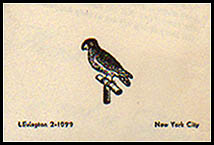
How is Dorothy Parker’s name connected to New York’s most famous bordello operator?
In the Roaring Twenties and the Depression Era Thirties, Polly Adler, a Russian immigrant who went from a Brooklyn sweatshop to entertaining both the upper crusts of society and mobsters, ran New York’s most notorious brothel. “I am one of those people who just can’t help getting a kick out of life — even when it’s a kick in the teeth,” she said.
She ran brothels all over the city, focusing mainly on the West Side of Manhattan. A few of her locations included 303 West 92nd Street (1923), 411 West End Avenue (1924), 57 West 58th Street (1926), and 115 West 73rd Street (1927). She had more than a dozen other locations as well. According to a Forbes article on the 1939 World’s Fair, Adler set up shop on Central Park West for fairgoers.
Adler counted among her many friends Robert Benchley and Dorothy Parker. Members of the Algonquin Round Table would frequent her establishment, situated in rented apartments scattered around the city. George S. Kaufman had a charge account with Polly. But Parker went for the ambiance of the place, which probably suited her taste for the sublime and the tacky.
Of Benchley, Adler wrote he was “the kindest, warmest-hearted man in the world.” He would rent out Adler’s place for lavish parties, bringing along Parker, politicians, and the literary crowd. At one party, a despondent prostitute jumped out an open window. After checking to make sure she was OK, Benchley kept the party rolling along.

Adler decked out her brothels in sumptuous décor, with plush carpets, expensive furniture, paintings, and walls lined with books. Benchley and Parker, who became regulars in July 1924, suggested titles for Adler’s library. Patrons came over for drinks, backgammon and card games as much as for the prostitutes. She made a lot of money selling booze during Prohibition, and all-night parties were regular functions. “Going to Polly’s?” was a new catch phrase in town.
But Adler’s personal life wasn’t rosy. She was always alone, rarely dated, and never settled down with anyone. For years she protected mob boss Dutch Schultz, who hid out at her place. She lived in fear that she would be killed when one of Schultz’ rivals found her out. Her only real friends were her whores and customers. But she was never apologetic about her career as a madam.
“If I was to make my living as a madam, I could not be concerned either with the rightness or wrongness of prostitution,” she wrote, “considered either from a moral or criminological standpoint. I had to look at it simply as a part of life, which exists today as it existed yesterday… The operation of any business in contingent on the law of supply and demand, and if there were no customers, there certainly would be no whorehouses. Prostitution exists because men are willing to pay for sexual gratification, and whatever men are willing to pay for, someone will provide.”
Adler was born April 16, 1900, in Yanow, Russia. She immigrated to New York when she was a teenager, and took menial jobs to get established. She found work in a corset factory in Brooklyn. By the time she was 24, she had fallen into the brothel business when she agreed to look after a gangster’s apartment. In a short while, she was a full-fledged madam and running one of the most popular whorehouses in the Twenties. With Prohibition in effect, New York was a wide-open and nearly lawless town, supervised by the corrupt but immensely popular mayor, Jimmy Walker.
Benchley and Parker frequented Adler’s brothel after a night of theater or beginning a night of parties. Benchley often spent the night there, and Adler claims in her autobiography A House is Not a Home (1951) that he even did some of his magazine writing in the company of her prostitutes. When she was in L.A., the pair had drinks at Chasen’s.
Adler was arrested 13 times and never had a conviction until the 1930s. Corrupt vice squad policemen, many on the take, constantly raided her. She spent thousands of dollars on bribes and kickbacks to the police. Some of the brothels she ran were located in the West Fifties near Seventh Avenue, 59th and Madison Avenue, 69th and Columbus Avenue, 77th and Amsterdam Avenue, West 83rd Street, West 54th Street, and for three years in the 1930s, on East 55th Street. According to Forbes magazine in 1939 while writing about the World’s Fair, Adler set up shop on Central Park West in the Sixties. Some New Yorkers are definitely residing in former whorehouses, just as some residents today are unwittingly under the same roof as active sex businesses.

By 1943 she was out of prostitution completely, and retired to Los Angeles. She went and got a college degree when she was approaching 50 years old. Her memoirs came out in 1953 (ghostwritten by the novelist Virginia Faulkner) and was a bestseller. She died in 1962 in Hollywood.
